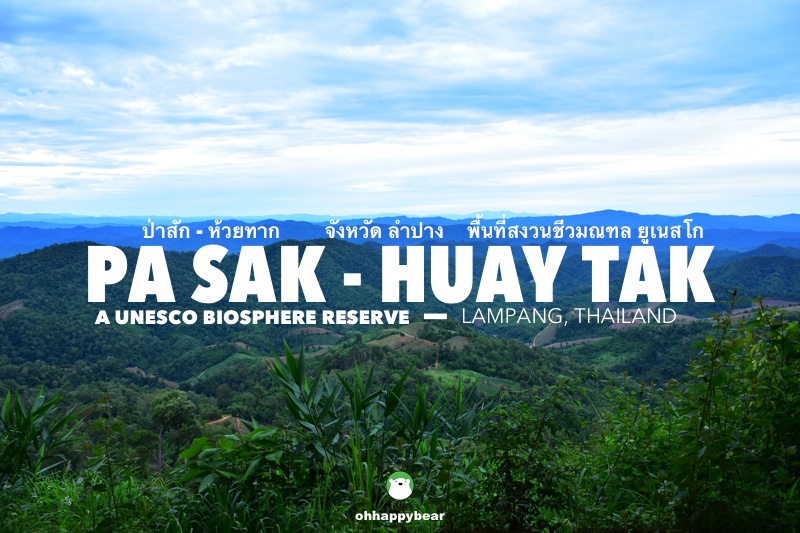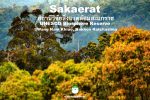Above: Pa Sak – Huay Tak UNESCO Biosphere Reserve in Lampang of Thailand is now becoming a part of the soon-to-be-official Tham Pha Thai National Park with a massive area of over 1,280 square kilometres or 800,000 rais, covering 5 districts including Ngao, Mueang, Chae Hom, Mae Mo, and Wang Nuea of Lampang. Picture courtesy of Pasak – Huay Tak UNESCO Biosphere Reserve.
It all started with teaks – Tectona grandis – or ‘Sak สัก,’ the wood that is synonymous with premium and valuable wooden products that never fail to incite the nodding approval from wood experts. Sak used to be a big economic force in Thailand, especially in the north. But now, the real teak wood is so hard to find that when we had the actual growing trees conserved and cultivated in a globally-recognised UNESCO Biosphere Reserve, it was such a big and amazing deal. Another incredible feat for nature, if you will, in our Kingdom of Thailand.
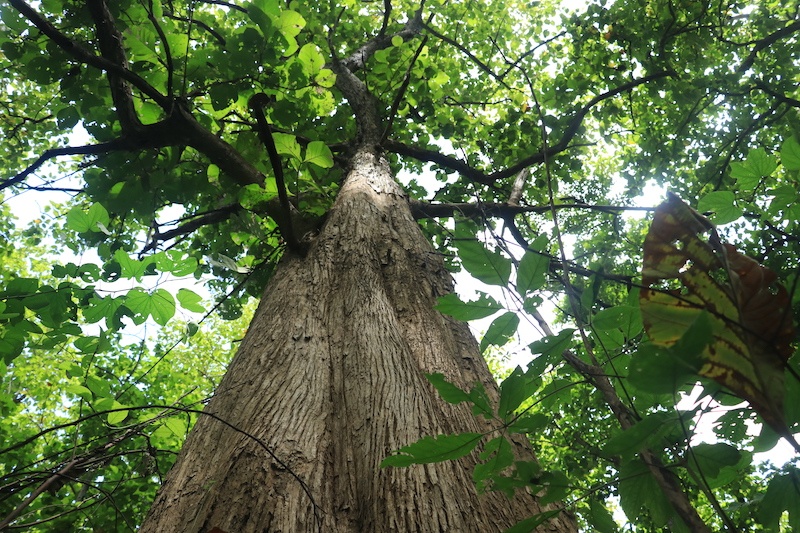 Above: Teak – Tectona grandis – is a deciduous tree native of northern Thailand and the nearby hemisphere including Myanmar. The hardwood trees were a major economic force in the region since the mid-1800s. Picture courtesy of Pasak – Huay Tak UNESCO Biosphere Reserve.
Above: Teak – Tectona grandis – is a deciduous tree native of northern Thailand and the nearby hemisphere including Myanmar. The hardwood trees were a major economic force in the region since the mid-1800s. Picture courtesy of Pasak – Huay Tak UNESCO Biosphere Reserve.
The year 2021, also to be remembered with multiple waves of COVID-19 around the world, has been a blessing for the Thai forests. As I have mentioned in my previous post on Sakaerat – Thailand’s First UNESCO Biosphere Reserve in Nakhon Ratchasima, our Kaeng Krachan Forest Complex in our western sphere became the latest UNESCO Natural World Heritage back in July. And then in September, Doi Chiang Dao in Chiang Mai was enlisted as another of our country’s UNESCO Biosphere Reserve. And all that prompted me to explore our own backyards, things that we didn’t know hidden. As valuable as they are, these are indeed some unsung gems.
 Above: A conserved teak forest at Pa Sak – Huay Tak UNESCO Biosphere Reserve, now a part of Tham Pha Thai National Park in Ngao District, about 65 kilometres northwest of the northern province of Lampang. Picture courtesy of Pasak – Huay Tak UNESCO Biosphere Reserve.
Above: A conserved teak forest at Pa Sak – Huay Tak UNESCO Biosphere Reserve, now a part of Tham Pha Thai National Park in Ngao District, about 65 kilometres northwest of the northern province of Lampang. Picture courtesy of Pasak – Huay Tak UNESCO Biosphere Reserve.
Looking at the list of UNESCO Biosphere Reserves here where all the places in Asia and the Pacific are listed by the years they were designated, you’ll see that Pa Sak-Huay Tak has been a Biosphere Reserve since 1977. Given the fact that teak and all other kinds of hardwoods have always been in high demand, it is incredible that we could properly conserve and, at the same time, preserve them. And we are reserving not just the teak trees, but the best teak trees there are in the entire domain of all teak species on this planet.
“We are blessed because Pa Sak- Huay Tak region has all the right elements and environments for teak trees and they grow best here to become the best teak varieties there are,” explains Mr. Wannachai Rakmitre, Director of Pa Sak-Huay Tak UNESCO Biosphere Reserve and Superintendent of the soon-to-be appointed Tham Pha Thai National Park in Lampang, a Lanna province about 600 kilometres north of Bangkok. “Natural selection has done its course, and here are the best strains of teak in the world and we have them all here in this Biosphere Reserve in Lampang. Anyone looking to propagate good varieties of teak trees might want to come here for the best resource.”
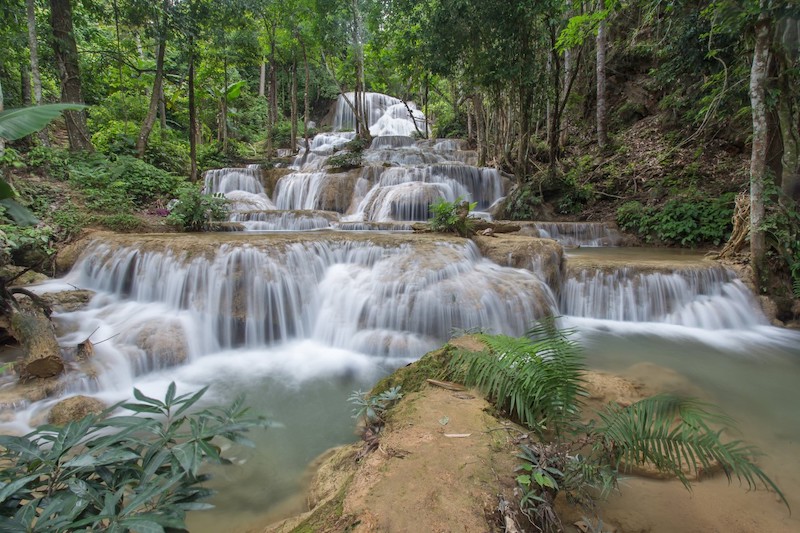 Above: Among many waterfalls dotting the national park is this Mae Kae (Kao Fu) waterfall where visitors can get freshened up in the sceneries. Picture courtesy of Pasak – Huay Tak UNESCO Biosphere Reserve.
Above: Among many waterfalls dotting the national park is this Mae Kae (Kao Fu) waterfall where visitors can get freshened up in the sceneries. Picture courtesy of Pasak – Huay Tak UNESCO Biosphere Reserve.
As declared in the UNESCO’s document, Pa Sak – Huay Tak Biosphere Reserve initially contains a total area of 29,440 hectares or 184,000 rais (or about 295 square kilometres) with the core area, or the most crucial, most fragile area that needs the highest protection, at about 10% or about 16,750 rais or 26.8 square kilometres. This Biosphere Reserve is in Ngao district, about 65 kilometres northwest of Lampang town. The area used to be a part of Tham Pha Thai Forest Park วนอุทยานถ้ำผาไท which is now being expanded and in the process of being appointed as a new national park of the same name.
“When it is official, Tham Pa Thai National Park will have a massive area of more than 800,000 rais, or 1,280 square kilometres (about 128,000 hectares) which is over four times larger than the original Biosphere Reserve’s area. Better than that, being a part of a national park, Huay Tak – Pa Sak Biosphere Reserve will also be legally protected under the regulations and laws of Thailand’s national parks. And that means we can enforce laws to protect the area better in the future,” explains Mr. Wannachai.
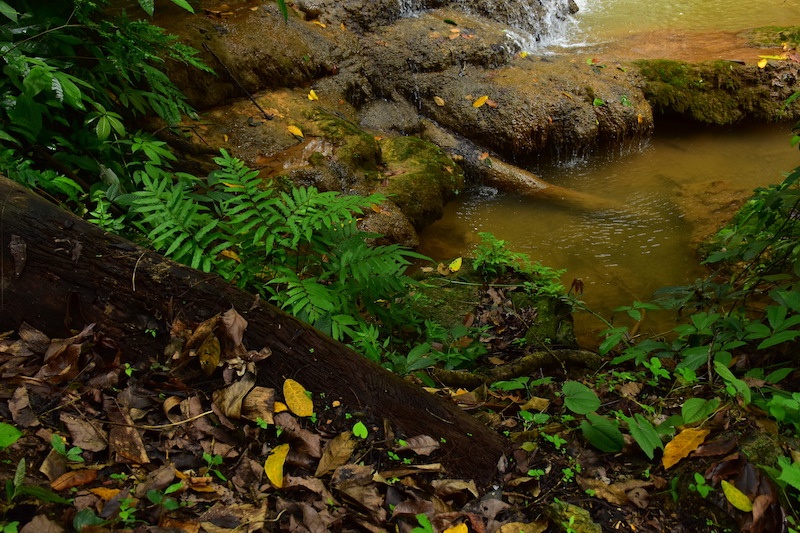 Above: The peace of nature cannot be replaced or substituted or recreated anywhere, no matter how advanced we have been technologically speaking. Picture courtesy of Pasak – Huay Tak UNESCO Biosphere Reserve.
Above: The peace of nature cannot be replaced or substituted or recreated anywhere, no matter how advanced we have been technologically speaking. Picture courtesy of Pasak – Huay Tak UNESCO Biosphere Reserve.
Teak – as we all know – is closely intertwined with Thai history since the day we began harvesting the wood for utility and trading purposes. As a part of native deciduous forests of the Thai north, teak has been a political, socio-economic driving force that led to our country’s massive logging, deforestation that eventually gave birth to managed forestation, the establishment of the Royal Forest Department (กรมป่าไม้) and a series of forestation acts that try to control logging, hauling, moving, and procuring teak and woods and timber from other hardwood trees.
We can now still see remnants of teak in their glories of those days in the forms of mansions, temples, houses, official buildings, and so on in various parts of the country. In Chiang Mai, where the international treaty that led to more logging and international teak trade began back in the late 1800s, colonial-style buildings, some originated as consulates, still stand, with many beautifully restored, cherished, and repurposed.
In Phrae, about 200 kilometres southwest of Chiang Mai where logging used to be major, teak mansions are still a part of their current charms. At the private Vongburi House, visitors can browse through the family’s all-in-pastel-pink teak house and finish their tour at the gallery down in the basement that, with old pictures and framed captions, depicts the logging history of Phrae. A thing we can look back to the natural abundance of our country, and at the same appreciate and nurture what we have left for the next generations to come.
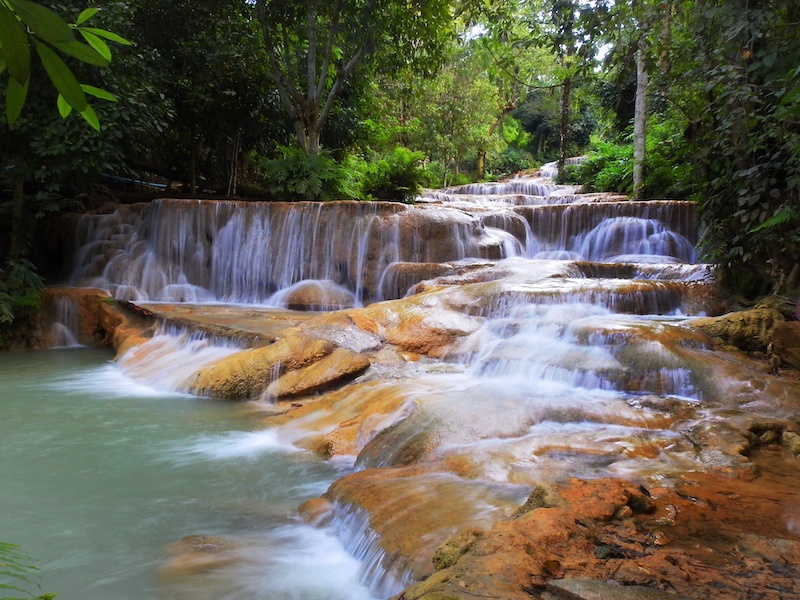 Above: Mae Kae (Kao Fu) Waterfall is about 45 kilometres north of the national park’s headquarters. Picture courtesy of Tham Pha Thai National Park.
Above: Mae Kae (Kao Fu) Waterfall is about 45 kilometres north of the national park’s headquarters. Picture courtesy of Tham Pha Thai National Park.
According to an extensive document entitled ‘Thai Teak Knowledge’ by the Royal Forestry Department published in 2013, there are as much as three ‘Teak Genetic Improvement Center (ศูนย์บำรุงพันธุ์ไม้สัก)’ in Thailand. At Ngao Silvicultural Research Division, a stone’s throw from the Pa Sak – Huay Tak Biosphere Reserve, almost 600 teak trees, selected from everywhere around the country – from the wild and from laboratory’s extensive selections, are preserved for further propagations. All in all, Thailand has over 30 Silvicultural Research Divisions where seeds of teak and other valuable trees are preserved for further use in the planting and growing processes. Legally speaking, teak trees everywhere in Thailand – privately grown, in the conserved and protected areas, or wild in the forests – are protected wood. Anyone wishing to log or process teak will need to go through a long series of legal requirements set up to sustain and preserve the trees.
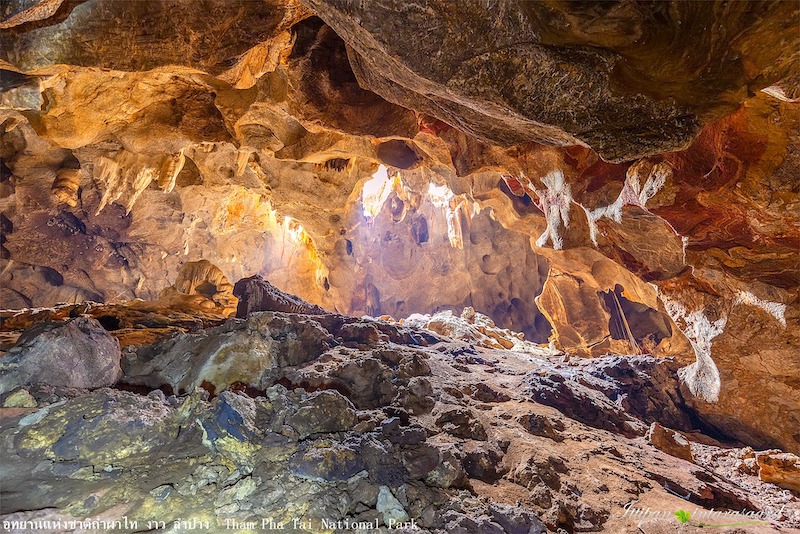 Above: Tham Pha Thai or Pha Thai Cave – the namesake of the national park. Picture courtesy of Tham Pha Thai National Park.
Above: Tham Pha Thai or Pha Thai Cave – the namesake of the national park. Picture courtesy of Tham Pha Thai National Park.
In the preserved area of the wild forests, teak trees grow tall, with straight and often buttressed stems and spreading crowds. To many of us, they look not unlike any trees in a forest. As a deciduous type, teak trees shed their leaves during the dry season and grow them all back come at the fresh rains. They are a great barometer of the seasonal cycles.
“Visitors can come over and enjoy the grandeur of our teaks,” says Mr. Wannachai. “And for those who are into it, we hope this will be your haven of all things you need to know about this valuable tree. But then, our national park has so much more to offer once you are in the area.”
With the abundance of nature, the high mountainous terrains, the lush areas dense with forests, homes, and all the wild animals, Tham Pha Thai National Park also features traces of prehistoric settlements. At Ban Huay Community, about 36 kilometres north of the park’s main office, historic paintings showcase lives lived here more than 3,000 years ago. Those chasing waterfalls can enjoy many choices from Mae Kae Waterfall or Kao Fu Waterfall and also Tad Moey Waterfall. Trekking and all things natural are also possible.
“With all the information now easily available online, visitors who wish to spend time in the forest can now get themselves better prepared. I’d recommend them to peruse things they can and cannot do so they will have the best of their time visiting,” the superintendent explains.
 Above: Green on green, the nature in the teak forest at Pa Sak – Huay Tak UNESCO Biosphere Reserve. Picture courtesy of Pasak – Huay Tak UNESCO Biosphere Reserve.
Above: Green on green, the nature in the teak forest at Pa Sak – Huay Tak UNESCO Biosphere Reserve. Picture courtesy of Pasak – Huay Tak UNESCO Biosphere Reserve.
Being a newly-appointed superintendent of a newly-appointed national park with a massive area, Mr. Wannachai, a forestry specialist, is faced with such a daunting task. “Park ranger is not a walk-in-the-park kind of job,” he explains. “In fact, it takes and needs a whole lot from a human being. A park ranger needs to be strong, both physically and mentally, not to mention being wholeheartedly dedicated. Every day on a patrol, we see problems, and solving them is certainly not a turnkey, straight-line way.”
Human encroachments, arsons, and poaching are the main and constant problems of forests everywhere. Now with global warming, natural disasters such as wildfires and flash flooding are also impending and expected. And good relationships with the surrounding communities are key to sustainable preservations everywhere.
“Our park rangers, apart from doing their jobs as all formally described, are also liaisons to the communities,” says Mr. Wannachai. “Creating a good rapport with the communities while also being strong enough to protect is definitely not an easy job. But it is our job, and we vow to do our best protecting our forests.”
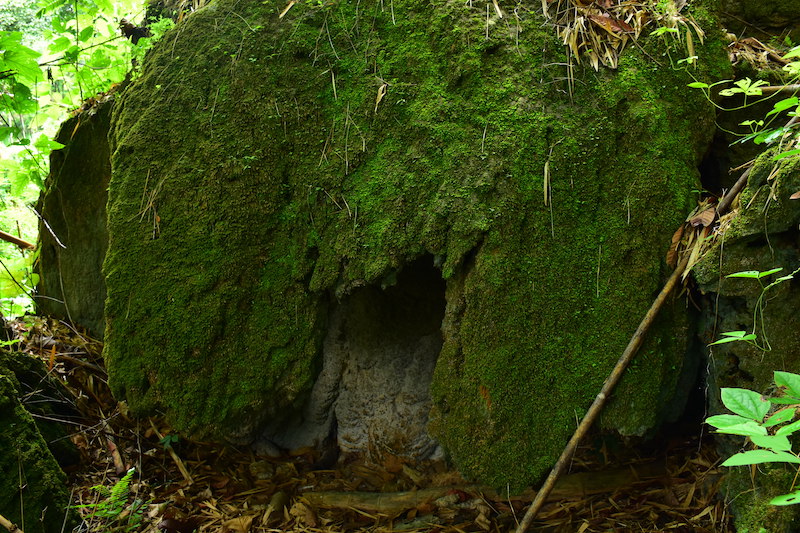 Above: Hope your happiness is one with nature, for there’s no healing the world can offer better than the natural one. Picture courtesy of Pasak – Huay Tak UNESCO Biosphere Reserve.
Above: Hope your happiness is one with nature, for there’s no healing the world can offer better than the natural one. Picture courtesy of Pasak – Huay Tak UNESCO Biosphere Reserve.
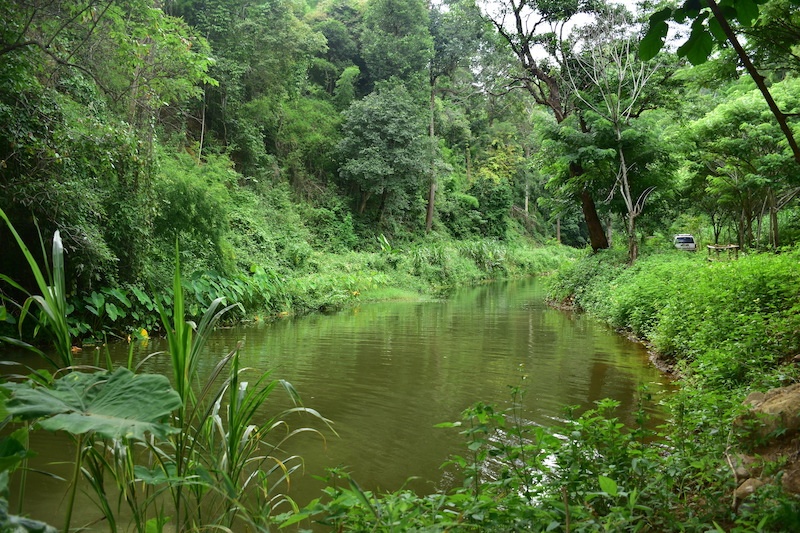 Above: A scene from Pa Sak – Huay Tak Biosphere Reserve. We too, can help protect our forests by knowing what we can and cannot do while in the forest. Tender love and care are key! Picture courtesy of Pasak – Huay Tak UNESCO Biosphere Reserve.
Above: A scene from Pa Sak – Huay Tak Biosphere Reserve. We too, can help protect our forests by knowing what we can and cannot do while in the forest. Tender love and care are key! Picture courtesy of Pasak – Huay Tak UNESCO Biosphere Reserve.
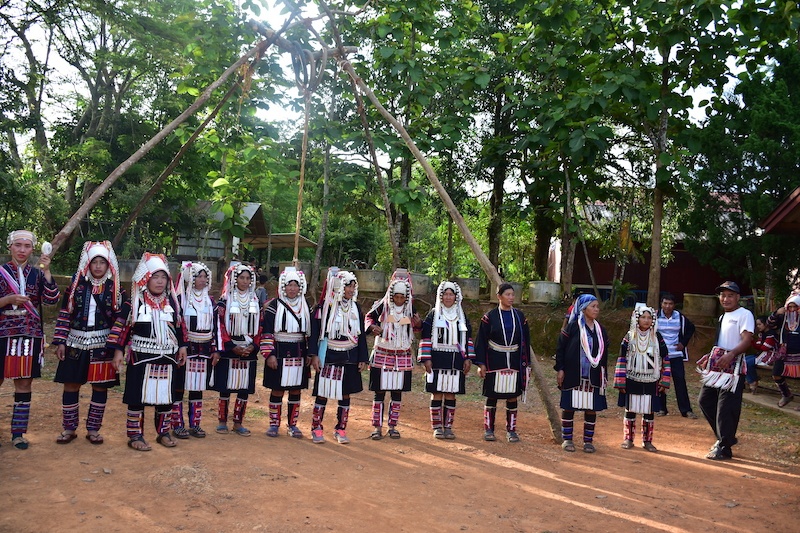 Above: Karen hill tribe is one of the native communities in Ngao District of Lampang. Picture courtesy of Tham Pha Thai National Park.
Above: Karen hill tribe is one of the native communities in Ngao District of Lampang. Picture courtesy of Tham Pha Thai National Park.
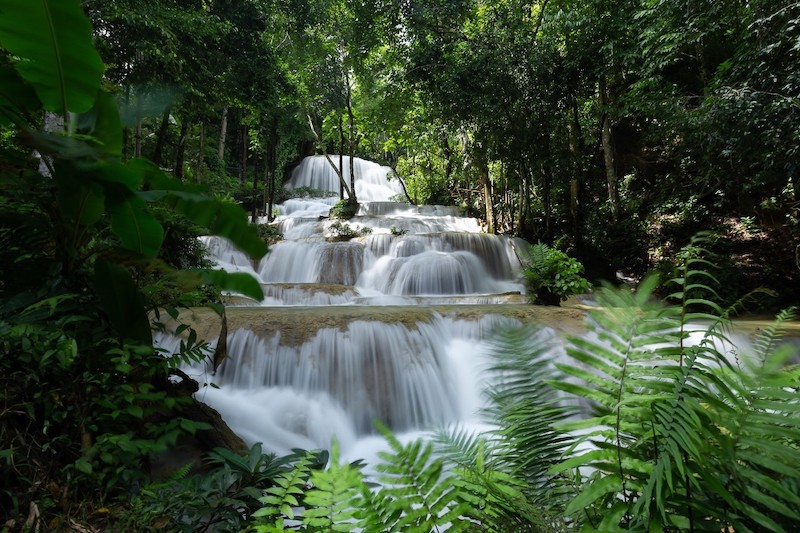 Above: Chasing down a waterfall! Picture courtesy of Tham Pha Thai National Park.
Above: Chasing down a waterfall! Picture courtesy of Tham Pha Thai National Park.
I would like to thank Khun Wannachai Rakmitre and his team at Pa Sak – Huay Tak UNESCO Biosphere Reserve and Tham Pha Thai National Park for the information, pictures, and all the assistance. For more information about Pa Sak – Huay Tak UNESCO Biosphere Reserve, go to https://www.facebook.com/huaytakteakbiosphere/
For more information about Tham Pha Thai National Park, visit Tham Pha Thai National Park.
ดิฉันขอขอบพระคุณหัวหน้าอุทยานแห่งชาติถ้ำผาไท และผู้จัดการพื้นที่สงวนชีวมณฑลป่าสัก ห้วยทาก อำเภองาว จังหวัดลำปาง คุณวรรณชัย รักมิตร และทีมงามทั้งด้าน social media และเจ้าหน้าที่พิทักษ์ป่าในทีมงานอย่างสูงมา ณที่นี้ค่ะ
List of Thailand’s all five UNESCO Biosphere Reserves (as of October 2021)
– Sakaerat Biosphere Reserve พื้นที่สงวนชีวมณฑลสะแกราช in Nakhon Ratchasima represents dry dipterocarp forest or Pa Teng Rang ป่าเต็งรัง and dry evergreen forest or Pa Dib Lang ป่าดิบแล้ง (listed 1976)
– Huay Tak Teak Biosphere Reserve พื้นที่สงวนชีวมณฑลป่าสัก ห้วยทาก in Lampang represents Thailand’s teak forests (listed in 1977)
– Mae Sa – Kog Ma Biosphere Reserve พื้นที่สงวนชีวมณฑลแม่สา คอกม้า in Doi Pui, Chiang Mai represents hill evergreen forests or Pa Dib Khao ป่าดิบเขา (listed in 1977)
– Ranong Biosphere Reserve พื้นที่สงวนชีวมณฑลระนอง represent the mangrove forests (listed 1997)
– Doi Chiang Dao Biosphere Reserve พื้นที่สงวนชีวมณฑลดอยเชียงดาว in Chiang Mai represents karst highland forest or Pa Khao Hin Poon ป่าเขาหินปูน (listed 2021)
A LITTLE NOTE FROM US: If you are enjoying reading this blog, as we hope you all are, please kindly consider making a donation to charity causes listed HERE as a way to give us support. Your acts of kindness are always appreciated. Many thanks.
MORE ABOUT THAILAND’S UNESCO WORLD HERITAGE SITES
KAENG KRACHAN – UNESCO NATURAL WORLD HERITAGE SITE
PHUKET – UNESCO CITY OF GASTRONOMY
Ban Chiang Archeological Site, Udon Thani – UNESCO World Heritage
SUKHOTHAI HISTORICAL PARK – UNESCO WORLD HERITAGE
AYUTTHAYA HISTORICAL CITY – UNESCO WORLD HERITAGE
